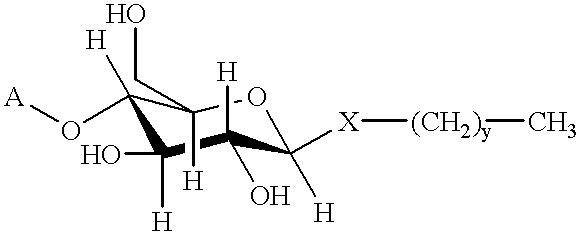Method for recovery of proteins prepared by recombinant DNA procedures
a dna-based protein and dna technology, applied in the field of dna-based protein recovery, can solve the problems of limited recovery rate, limited recovery rate, and inability to recover soluble recombinant proteins in high yields
- Summary
- Abstract
- Description
- Claims
- Application Information
AI Technical Summary
Benefits of technology
Problems solved by technology
Method used
Image
Examples
example ii
A reagent solution useful in accomplishing the method of the present invention is prepared by forming an aqueous solution of octylthioglucoside in TRIS buffer, pH 7.5, (1% w / v), hereinafter referred to as the "Reagent Solution". Cells contained in wet E.coli pellets prepared in accordance with Example I containing expressed green fluorescent protein (GFP), from 250 ml of culture were suspended in 10 ml of the Reagent Solution and in 10 ml of phosphate buffer saline (PBS). For cell lysis and extraction with the Reagent Solution, the suspension was gently shaken for 10 minutes for a first round of extraction and then two minutes for four subsequent rounds. For lysis with sonication in the PBS buffer, the suspension was sonicated for two minutes with 50% pulse per round. In both cases, after each round of extraction, the soluble proteins were separated from cellular debris by centrifugation at 27000.times.g for 15 minutes. After the five rounds of extraction, the final pellets (P in FI...
example iii
This example illustrates the use of the present invention to lyse and extract protein from insect cells.
Insect Sf9 cells grown in 100 mm plates were infected with a recombinant baculovirus expressing 6.times.Histidine-tagged GFP. Four days after infection, the culture media were removed and 1 ml of the Reagent Solution described in Example II was added to the plates. Cells from 10 plates were pooled together and the soluble proteins were obtained from the supernatant after centrifugation at 27,000 .times.g for 15 minutes on a Beckman JA20 rotor.
example iv
This example illustrates the use of the present invention for the lysis of bacteria containing different recombinantly produced proteins and the purification of these recombinant proteins contained in inclusion bodies.
Bacterial pellets from a 250 ml of bacterial culture obtained as in Example I were resuspended in 10 ml of the Reagent Solution as prepared in Example II. The soluble and insoluble fractions were separated by centrifugation at 27,000.times.g for 15 minutes. The supernatant was collected as the soluble protein fraction (S in FIG. 3) and the pellets containing inclusion bodies were resuspended in 10 ml of the Reagent Solution. For removing cell debris (evident in FIG. 1, lane P) from the inclusion body, lysozyme was added to a final concentration of 200 .mu.g / ml and the suspension was incubated at room temperature for 5 minutes. Then, 100 ml of water was added to the suspension and the inclusion bodies were collected by centrifugation at 27,500.times.g for 15 minutes. Th...
PUM
| Property | Measurement | Unit |
|---|---|---|
| temperature | aaaaa | aaaaa |
| temperature | aaaaa | aaaaa |
| pH | aaaaa | aaaaa |
Abstract
Description
Claims
Application Information
 Login to View More
Login to View More - R&D
- Intellectual Property
- Life Sciences
- Materials
- Tech Scout
- Unparalleled Data Quality
- Higher Quality Content
- 60% Fewer Hallucinations
Browse by: Latest US Patents, China's latest patents, Technical Efficacy Thesaurus, Application Domain, Technology Topic, Popular Technical Reports.
© 2025 PatSnap. All rights reserved.Legal|Privacy policy|Modern Slavery Act Transparency Statement|Sitemap|About US| Contact US: help@patsnap.com


